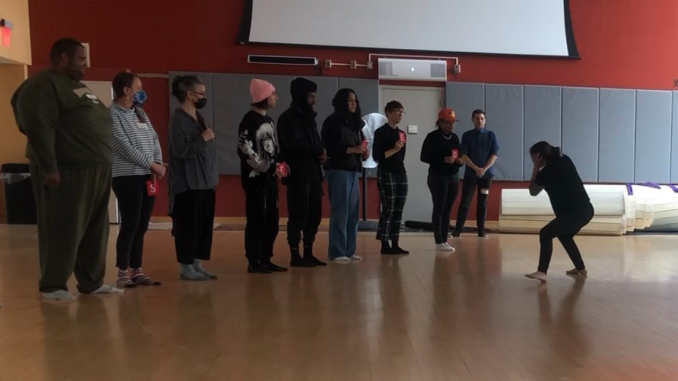
By Allison Dubrow
Performing artist and choreographer Anna Gichan had a powerfully interactive performance titled “Access Denied” in the ballet studio of the West Quad Building last Friday, Feb. 17. Being the first open event in three years, Gichan’s dance brought much excitement to her audience and those who helped behind the scenes.
Gichan delivered a vulnerable piece that is currently still being developed and demonstrates her progress report with her identity crisis. With her expertise honed from her time at Rutgers University’s Mason Gross School of the Arts and the Jerusalem Academy of Music and Dance, Gichan has made strides in the contemporary dance scene. As Brooklyn College’s CUNY Dance Initiative artist in residence, she brings to campus her art that stems from her background in ballet and gymnastics as a deaf performing artist.
“Brooklyn College has been one of our partners since we started in 2014, and Anna Gichan has been rehearsing at the college last year and this year through an arts and social justice residency program that we started with Brooklyn Arts Exchange,” said Alyssa Alpine, CDI’s director.
During her latest performance, Gichan mentioned how she felt very isolated during the pandemic and was not sure how to go about expressing herself. At the time, Gichan got an updated hearing test that told her she had lost all of her hearing in her left ear and that her right ear was terrible. Due to COVID-19, everything shut down, and as a dancer and choreographer, she felt very lonesome.
“I had nobody to talk to about it […] So that I think initially created a very messy, ‘how do I even go about expressing who am I? Who are you and what do you want to share with the world,’” said Gichan.
This led the artist with New Jersey roots to make her performance interactive with those in attendance. As a result of feeling like an outsider and having a lot of personal space working against her, she wanted more control over how people felt when they walked into her performance.
When everyone initially entered the room, they all sat facing the dance studio and looking at Gichan, who went around and had participants hold a specific card. Then, audience members were instructed to find their spot on a line of tape that she put out on the floor. Those in attendance later read aloud what their card said before she began to dance.
When she delved into her craft, everyone could feel the intensity of the story she was telling and the challenges she overcame. The music seemed to represent what she would hear when she was younger, and the different kinds of sounds her hearing tests would make. Her movement demonstrated the pain that she felt and one could see how she appeared lost and confused in trying to find out where she fits in the world. Toward the end of her performance, she had all repeat after her and say, “Deaf children need sign language access.”
“Watching Anna perform, I kind of felt an emotional attachment to her,” said BC student Shanique Campbell. “She moved really freely, and you could see the joy as well as the sad aspect of it as well.”
Gichan stated during the event that her dream is for everyone to feel comfortable in the space that they’re in and in their own skin. “I am whole as I am. I don’t need to be fixed,” she said. With the help of those around her, she recognized that one could ask for the things they need to gain a better understanding of their surroundings.
At the closing of Gichan’s performance, participants were able to interact directly with her through a Q&A session. After being asked about the role her other senses play in her dance, Gichan explained that she can’t see out of her left eye, which prompted her to pay extra attention to her senses. When she was younger, she did this experiment of shutting her eyes, taking out her hearing aid, and walking around to see if she could tell who was around her. As a result of her doing so, a lot of the movement she creates is internal and based on how she feels.
As Gichan continues to develop her performance, she noted that she wants to show more joy along with the pain. Being that her right and left ears hear differently, she would also like to create a soundscape that represents that.
Artists who form part of Brooklyn College’s CDI program are given a lot of rehearsal space in the West Quad studio over the course of each year to develop their “creative development residency.” In Anna Gichan’s case, she is set to continue exploring her deaf identity.
Gichan will continue rehearsing at Brooklyn College through June 30, and she also does workshops from time to time. To follow Gichan’s progress, visit: https://annagichan.com/.
